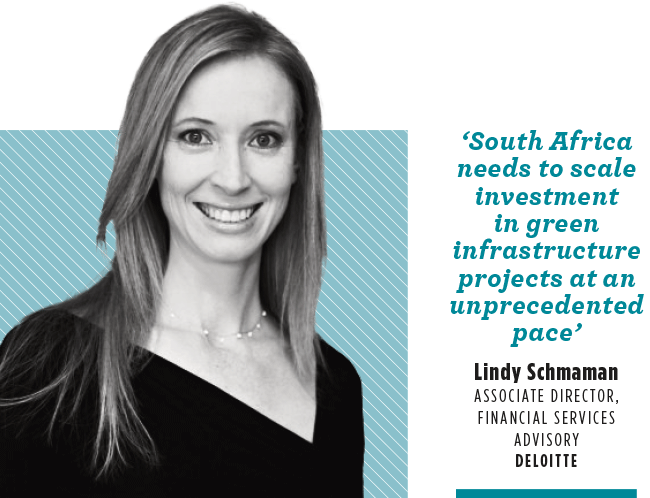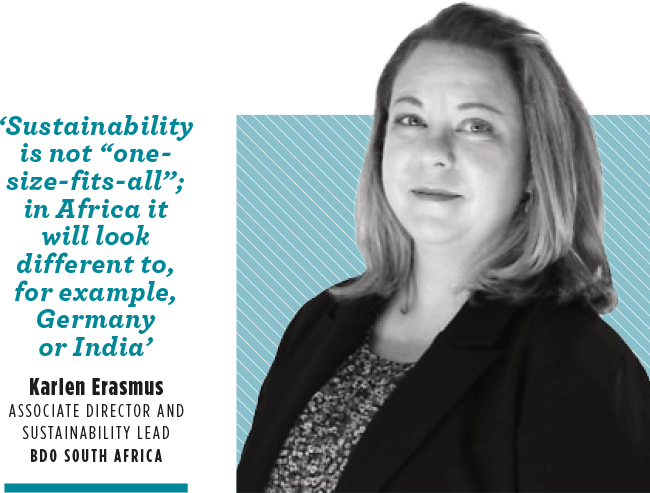The green taxonomy has been likened to a guest list, where an investment has to meet specific sustainability criteria to make it onto the list. And those investments that misbehave – in terms of ESG issues – are not welcome until they have cleaned up their act.
On 1 April 2022, Treasury officially launched a guest list of such a kind – the first edition of the South African Green Finance Taxonomy for environmentally sustainable economic activities. This is a big deal for the fight against greenwashing and for sustainable investing, which is one of the fastest-growing forms of finance worldwide.
The ‘living’ document is a classification system that defines a minimum set of assets, projects and sectors that are eligible to be defined as ‘green’ or environmentally friendly. ‘It can be used by investors, issuers and other financial-sector participants to track, monitor, and demonstrate the credentials of their green activities in a more confident and efficient way,’ according to Treasury.
‘The Green Finance Taxonomy will help investors and financial institutions make more informed decisions on “green” projects,’ says Patrick Heron, associate at Webber Wentzel law firm. ‘The focus of the first edition is climate change, but it’s intended that it will extend to further issues in the future, such as issues concerning biodiversity and effective land-use. The objectives are to support a future economy reference; to be a tool to drive change; and to be a communication enabler.’
He adds that the document will be vital for promoting transparency and accountability in the market while boosting investor confidence and certainty.
‘The Green Taxonomy followed National Treasury’s publication in 2021 of the technical paper Financing a Sustainable Economy, focusing on climate risks and the opportunities for the financial sector to make a positive contribution to green objectives and facilitate the transition to a low-carbon economy that is socially inclusive and sustainable,’ says Heron.
The World Bank Group – which issued a guide on how to develop a national green taxonomy for emerging markets based on its experiences in supporting such initiatives in SA (as well as Colombia, Malaysia and Mongolia) – explains why this kind of classification is desirable.
‘The lack of clarity about which activities and assets can be defined as green has long posed a barrier to scaling up green finance,’ according to the group. ‘A green taxonomy identifies the activities or investments that deliver on environmental objectives, helping drive capital more efficiently towards priority environmentally sustainable projects. The guide can help banks and other financial institutions originate and structure green banking products, such as loans, credits and guarantees. It can also help investors identify opportunities that comply with sustainability criteria for impact investments.’ To help countries learn from others, the guide also includes an overview of existing green taxonomies, such those by Bangladesh, China, Mongolia and the EU.
Several countries are developing their own national or regional sustainable taxonomies, including the UK (which is adapting the EU metrics to its own market), Canada, Mexico, Russia, Chile, India and the Association of Southeast Asian Nations with its 10 member states. The International Platform on Sustainable Finance, a multilateral forum, is working to minimise fragmentation and find common ground between the various taxonomies.
The primary reason for the launch of the country’s green taxonomy is to mobilise the urgent capital needed locally for climate mitigation and adaptation efforts, explains Lindy Schmaman, associate director in the financial services advisory at Deloitte. ‘South Africa needs to scale investment in green infrastructure projects at an unprecedented pace in order to meet our Nationally Determined Contributions and align with the goals of the Paris Agreement. So the first priority is to make sure the platform exists for those who want to attract financing but need to demonstrate their green credentials to investors in a consistent and transparent way.’
At this stage, SA’s green taxonomy features just two of its six central environmental objectives (climate-change mitigation and climate-change adaptation). However, the coverage will be expanded in future editions to include the specifications for the other four environmental objectives, namely sustainable use of water and marine resources; pollution prevention; sustainable resource use and circularity; and ecosystem protection and restoration.
To perform the classification, taxonomy users are required to demonstrate that the economic activity under consideration meets all three of the following principles – that it ‘makes a significant contribution’ towards at least one of the environmental objectives; it ‘does no significant harm’ to any of the other taxonomy objectives; and that it meets minimum social standards (referred to as minimum social safeguards). The process to evaluate an activity, asset or project as ‘green’ provides a binary result; so instead of rating or grading the ‘green-ness’, it’s either ‘taxonomy-aligned’ or ‘not’.
While this may sound rather abstract, there are tangible benefits for ordinary South Africans and businesses. ‘Personally, I’m really excited by the key focus on climate-change adaptation,’ according to Karien Erasmus, associate director and sustainability lead at BDO South Africa.
‘Climate-change adaptation is critical in building the necessary societal resilience we will need to withstand the impacts of rapidly changing climatic patterns,’ she says.
‘If we think about the recent, significant flooding in KZN, or the drought [‘Day Zero’] in Cape Town and now in Gqeberha, the need for climate-resilient infrastructure is evident. In this regard, including adaptation as part of our taxonomy could see increased investment into these areas to support municipal and localised climate resilience.’
Local is lekker when it comes to green taxonomies. Although SA’s green taxonomy is based on the EU model, it strongly reflects our local priorities, distilled from national policy and legislation.
‘Sustainability is not “one-size-fits-all”; in Africa it will look different to, for example, Germany or India,’ says Erasmus. ‘This is because each country has its own developmental challenges, its own unique opportunities, and a unique macro-economic context.
‘Similarly, “green” does not mean the same thing, or look alike, in two different countries. There certainly are correlating basic, fundamental concepts, which allow us to understand what we mean by “green” from an economic perspective. This baseline understanding is important to avoid too many divergent definitions or concepts, but country-specific nuances are very important and will imply different approaches to taxonomy implications.’
The reference to national priorities is particularly important. According to Erasmus, a country’s national priorities should determine, inform and guide how it defines ‘green’ and what it aims to achieve through the implementation of a ‘green taxonomy’. As such, these taxonomies cannot be ‘copied and pasted’.
So while SA’s and the EU’s green taxonomies are very similar, there are differences in some criteria being either more or less ambitious or detailed in their description. The EU taxonomy also requires mandatory disclosure of relevant information from corporates and financial market participants, while SA has taken a phased approach to implementation.
‘Keep in mind, when comparing the South African context to that of the EU, that we have robust environmental legislation which also governs activities and impact mitigation,’ says Erasmus. ‘Our corporate sector is already reporting, across various platforms, on environmental and broader sustainability aspects, as required or supported by our regulatory environment. The SA green taxonomy, however, as a macro-economic mechanism, must be phased in to ensure the necessary buy-in and entrenchment across the regulatory landscape.’
However, one should not underestimate the time, effort and cost required to assess, monitor and report on taxonomy alignment, warns Schmaman. ‘The SA taxonomy working group has indicated that it’s currently exploring ways of supporting the implementation and embedding it into the country’s reporting landscape. So although there has been no formal communication on mandatory reporting yet, the expectations are that it will follow in time.’
She explains that, ultimately, the taxonomy should stimulate the development of green industries in SA. ‘It gives credibility to our green-labelled investments, thereby attracting both local and international funding. It is especially important for attracting foreign investors seeking internationally recognised green investments, and who are expecting disclosures in line with the rapidly developing international reporting landscape on climate and sustainability,’ she says.
‘The taxonomy has the potential to broaden our current investor base, unlock investment opportunities and incentivise capital flows into South Africa’s green investment market.’
An important point is that green taxonomies don’t apply only to ‘obviously green’ industries. ‘For example, a mining operation can use the taxonomy to measure and demonstrate improvements in the way it generates alloys, produces electricity, treats water, and so on,’ says David Geral, head of banking and financial services regulatory at Bowmans SA.
‘Another example is that insurance companies can be rated based on the products they develop to mitigate the commercial risk of sustainable activities, or for example through sharing climate-related claims data and mitigation techniques.’
Essentially, the green taxonomy aims to encourage businesses across all sectors and of all sizes – from green industries to those with high-environmental impact – to improve the sustainability of their activities. Now that we have the classifications to define ‘green’, it may inspire those not included on the ‘guest list’ to find ways to join the party.











